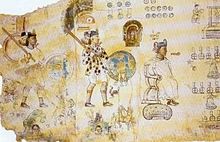
The Codex of Tlatelolco is a pictorial central Mexican manuscript containing a history of events occurring in Tlatelolco, from before 1550 to after 1564, in the period before and after the Spanish conquest of the Aztec Empire.[1][2][3][4] Due to its name, it is sometimes confused with the Latin script, the manuscript Anales de Tlatelolco, also sometimes called the same name.[2]
The codex, drawn up using the Aztec ideographic script, describes participation of Tlatelolco warriors in putting an end to the rebellion in Mexico's northern frontiers in 1541.[4]
The Codex, in addition to the so-called The Tlaxcala canvases are sometimes cited as one of the clearest examples of the emerging cultural mestisization in Mexican society in the first decades after the Conquest: within the text, new rulers are presented as continuators of old traditions, in the illustrations warriors dressed in jaguar skins and costumes of eagles dance at the foot of the new Spanish the viceroy of New Spain and the new archbishop in the same way as they are depicted on the previous pages dancing in front of the priests and tlatoani. The pictographic layer of the codex shows the influences of Renaissance European art.[3]
- ^ Donald Robertson (1994). Mexican manuscript painting of the early colonial period : the metropolitan schools. University of Oklahoma Press. pp. 163–166. ISBN 9780806126753. OCLC 30436784.
- ^ a b Rodrigo Martínez (January 2006). "Rafael Tena, Anales de Tlatelolco, México, Conaculta (Cien de México), 2004, 207 pp". Dimensión Antropológica (in Spanish). 36: 173–181.
- ^ a b Serge Gruzinski (2014-02-20). The Conquest of Mexico: Westernization of Indian Societies from the 16th to the 18th Century. John Wiley & Sons. pp. 24, 29–30, 51, 62–63. ISBN 9780745683560.
- ^ a b José Rabasa (2000). Writing Violence on the Northern Frontier: The Historiography of Sixteenth-century New Mexico and Florida and the Legacy of Conquest. Duke University Press. pp. 13–15. ISBN 0822325675.